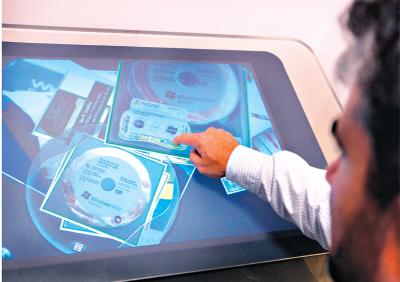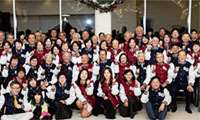
Microsoft is concentrating on large counterfeiters. Donal Keating, its forensics expert,displayed images of forged certificates of authencity.
By ASHLEE VANCELA FAMILIA MICHOACANA, the brutal Mexican crime cartel, has expanded into software. Mexican police on a house raid last year found rooms crammed with about 50 machines used to copy CDs and make counterfeit versions of software like Microsoft Office and Xbox video games. Some disks were even stamped with the initials FMM, which stands for Familia Morelia Michoacana.
checks for fake holograms and replicated disks, top left and right. It also compares certificates of authenticity, left, and stores its evidence.
The cartel evidently sees software piracy as a low-risk, high-profit complement to drugs, bribery and kidnapping. And it is not alone in this among the world’s crime syndicates, escalating worries at companies like Microsoft, Symantec and Adobe.
Groups in China, South America and Eastern Europe appear to have supply chains and sales networks rivaling those of legitimate businesses, says David Finn, Microsoft’s anti-piracy chief. Microsoft has adopted a hard-line stance against counterfeiting.
It has set up a sophisticated anti-piracy operation that dwarfs those of other software makers; the staff includes dozens of former government intelligence agents from the United States, Europe and Asia, who use a host of forensic technology tools for finding and convicting criminals.
But the hunt for pirates carries with it a cost to Microsoft’s reputation. The company’s profit from Windows and Office remains the envy of the technology industry, and critics contend that Microsoft simply charges too much for them.
In countries like India, where Microsoft encourages local police officers to conduct raids, the company can come off as a bully willing to go after its own business partners if they occasionally peddle counterfeit software to people who struggle to afford the real thing.
But Mr. Finn plays down the accusation that Microsoft would face less of a piracy threat if it just lowered prices. “We have seen no connection between piracy rates and price,” he says. “I think it’s a canard.” He argues that Microsoft has no choice but to be aggressive in its fight, saying its immense network of resellers and partners can’t make a living in areas flush with counterfeit software.
He says consumers and businesses are being coaxed into buying counterfeit products that either don’t work or do serious harm by clearing the way for various types of electronic fraud. And, crucially, the counterfeit software cuts into Microsoft’s profit.
A software industry trade group estimated the value of unlicensed software for all companies at $51.4 billion last year. Microsoft has demonstrated a rare ability to elicit the cooperation of law enforcement officials ? not only in India and Mexico, but also in China, Brazil, Colombia, Belize, Malaysia, Chile, Peru and Russia. But Microsoft’s pursuit of software counterfeiters begins in Dublin, at one of the company’s 10 crime labs.
Donal Keating, a physicist who leads Microsoft’s forensics work, has turned the lab into an anti-piracy playpen full of microscopes and other equipment used to analyze software disks.
The undercover operative of this group is Peter Anaman, a lawyer who was born in Ghana ; he taught hand-to-hand combat to soldiers in the French army and then taught himself how to write software. Through three online personas, Mr. Anaman befriends hackers who use stolen credit card numbers to set up Web sites for pirated products.
“It is part of gathering human intelligence and tracking relationships,” Mr. Anaman says. Using an artificial intelligence system, Microsoft scans the Web for suspicious, popular links and then sends takedown requests to Web service providers .
“The Web sites look professional,” he says. “And some of them even offer customer support through call centers in India.” He describes the groups behind these sites as “part of the dark Web,” saying they have links to huge spam, virus and fraud networks. About 75 other people, including former agents of the F.B.I., Secret Service and Interpol, work under Mr. Finn.
A former assistant United States attorney in New York, Mr. Finn directs this squad from a Paris office. He says Microsoft spends “north of $10 million” a year on its intelligence-gathering operations and about $200 million on developing anti-piracy technology. The software thieves monitored by Microsoft come in various shapes and sizes.
They include college students and grandmothers. But investigators spend much of their time on large-scale counterfeiters, examining how they produce and distribute their wares . The biggest counterfeit software bust in history occurred in July 2007 in southern China. Authorities found a warehouse where workers assembled disks, authentication materials and manuals and prepared them for shipping.
All told, investigators found $2 billion worth of counterfeit Microsoft software. Software produced by this syndicate turned up in 36 countries. Microsoft has found that operations of this scale tend to include all the trappings of legitimate businesses.
Workers spend years building up contacts at software resellers around the globe, offering them discounted versions of software. Many Microsoft products make users enter an activation code to register the software and have it work properly. The syndicates trade in stolen versions of these codes as well, and sometimes set up their own online authentication systems to give people the feeling they have a legitimate product.
About a decade ago, only a few companies had the expertise or the $10 million needed to buy machines that could press CDs and DVDs. Today, someone can spend about $100,000 to buy second-hand pressing gear. Crucially for Mr. Keating, each press leaves distinct identifying markers on the disks.
He spends much of his time running CDs through a glowing, briefcase-size machine ? and needs about six minutes to scan a disk and find patterns. To the untrained eye, the counterfeit software in Microsoft’s labs appears to be exact replicas, right down to the boxes.
Chinese counterfeiters mimic the built-in hologram simply by placing a holographic sticker across the entire surface of a CD; then they use other machines to erase some of the unique identifiers found at microscopic levels.
Such tactics have pushed Microsoft to create a new type of digital fingerprinting technology that scans a disk’s software code for special defects. The same techniques allow Microsoft to find malicious code that may have been injected in its products. But Microsoft’s anti-piracy efforts can have a public relations fallout.
The company recently altered its policies in Russia after a spate of incidents in which local security services seized computers of advocacy groups and opposition newspapers, using the pursuit of stolen software as a justification. Mr. Finn argues that Microsoft’s anti-piracy efforts and training of law enforcement are a benefit to countries that want to build out their tech sectors and show they value intellectual property. “Intellectual property is a critical engine of economic growth,” Mr. Finn says.
“That’s not just for large companies, but also for small businesses and entire countries. We work with governments that are realizing this is in their best interests."
스마터리빙
more [ 건강]
[ 건강]이제 혈관 건강도 챙기자!
[현대해운]우리 눈에 보이지 않기 때문에 혈관 건강을 챙기는 것은 결코 쉽지 않은데요. 여러분은 혈관 건강을 유지하기 위해 어떤 노력을 하시나요?
 [ 건강]
[ 건강]내 몸이 건강해지는 과일궁합
 [ 라이프]
[ 라이프]벌레야 물럿거라! 천연 해충제 만들기
 [ 건강]
[ 건강]혈압 낮추는데 좋은 식품
[현대해운]혈관 건강은 주로 노화가 진행되면서 지켜야 할 문제라고 인식되어 왔습니다. 최근 생활 패턴과 식생활의 변화로 혈관의 노화 진행이 빨라지고
사람·사람들
more많이 본 기사
- 초강경 추방 드라이브… 한인사회 불안… 1
- 트럼프 경제·이민 정책 지지율 급락
- 노화의 신호, 흰머리는 왜 생기나… … 1
- 부채증가 세계 최고… “상실감 위로한다며 1인당 60만원”
- ‘트럼프 골드카드’ 신청 시작 100만달러 내면 미 영주권
- ‘테라 사태’ 권도형 징역 15년
- DUI 차량, 애나하임 고교생 8명 덮쳐
- 김민선 학장 자선행사서 40만달러 기금조성
- 한국 교사 10명, 페어팩스 초등교 배치
- 재외투표율 79.5%… 투표자 수 미국 최다
- 이효리, 과거 인연도 소중.. ‘패밀리’ 김수로 만나 ‘다정’
- 임소정씨, VA 주하원의원 도전
- 이번 주말 ‘송년모임 대축제’… 단체·동문회 행사 절정
- “마약밀매·인신매매 등 국제범죄 척결” ‘국토안보 태스크포스’ 뉴욕지부 출범
- 김찬수씨, 포토맥 포럼에 2천달러 기부
- 소셜연금 NY 2,018달러·NJ 2,190달러
- ‘오바마케어 보조금’ 올해 말 종료 가능성 ↑ 커져
- MD한인회장 또‘무후보’
- 송미숙 전 이사장 단독 출마
- 경기고 56회 동창회, 더나눔하우스에 후원금 전달
- 무단 주차 견인료 150불⇨ 210불
- 멕시코·한·중 등 FTA 미체결국 ‘관세폭탄’
- [인터뷰] “한인 커뮤니티 지원하고 도움이 되는 협회될 것”
- VA 청정에너지 사업 재개되나
- 워싱턴 산악인, 스톤마운틴 정상에 서다
- 한양대 메릴랜드 동문회 20일 송년파티
- 전도연 “얼굴 근육 가장 많이 써…자백의 대가 이리 클 줄은”
- 검문 뚫고 목선 탈출… 마차도 ‘목숨 건’ 노벨평화상 참석
- 글로벌어린이재단 VA 지부, 2.20 클럽에 2,000달러 기부
- “박나래 前매니저 5000만원 지급? 과한 수당 요구” 주장
- 민주당서 크레젤·대넌 2명 출마
- 자녀들과 함께 세우는 부모님 자산 이전 계획
- “멍청한 이민국” 트럼프 비판에… 미, 비자 개선 속도전
- 시화집‘이별없는 사랑’ 발간
- 월남전 참전지회 워싱턴지회 18일 송년 행사
- 서재홍 씨, 동중부한인연합회장 출마
- “원만한 마무리 원해” 성시경, 10년 의리 배신한 전 매니저 ‘선처’
- 한인 업소들, 이번 주말 ‘할인 대전’ 돌입
- 글로벌어린이재단 연말모임
- LA 노인회 ‘팜스프링스 온천 투어’
- ‘숨은 나랏빚’ 국가보증채무, 내년 20조 넘게 늘어난다
- 파워볼 잭팟 10억 달러 13일 토요일 추첨
- [송년행사 화보] “친구야 반갑다… 선배님들 모두 건강하세요”
- 포브스 ‘여성파워 100인’에 케데헌
- 13일 추첨 파워볼 열풍 잭팟 10억달러 돌파
- 삼성SDI, 미국서 2조원 ‘잭팟’… ESS 배터리 첫 수주
- “성탄 분위기 망쳤다”…맥도날드, AI로 만든 광고 중단
- 베네수엘라 유조선 나포… “마두로 돈줄 차단”
- 에어프레미아, 워싱턴 DC 신규 취항
- 오픈뱅크, 장애인 특별달력 제작 화제
1/5지식톡

-
 테슬라 자동차 시트커버 장착
0
테슬라 자동차 시트커버 장착
0테슬라 시트커버, 사놓고 아직 못 씌우셨죠?장착이 생각보다 쉽지 않습니다.20년 경력 전문가에게 맡기세요 — 깔끔하고 딱 맞게 장착해드립니다!장착비용:앞좌석: $40뒷좌석: $60앞·뒷좌석 …
-
 식당용 부탄가스
0
식당용 부탄가스
0식당용 부탄가스 홀세일 합니다 로스앤젤레스 다운타운 픽업 가능 안녕 하세요?강아지 & 고양이 모든 애완동물 / 반려동물 식품 & 모든 애완동물/반려동물 관련 제품들 전문적으로 홀세일/취급하는 회사 입니다 100% …
-
 ACSL 국제 컴퓨터 과학 대회, …
0
ACSL 국제 컴퓨터 과학 대회, …
0웹사이트 : www.eduspot.co.kr 카카오톡 상담하기 : https://pf.kakao.com/_BEQWxb블로그 : https://blog.naver.com/eduspotmain안녕하세요, 에듀스팟입니다…
-
 바디프렌드 안마의자 창고 리퍼브 세…
0
바디프렌드 안마의자 창고 리퍼브 세…
0거의 새제품급 리퍼브 안마의자 대방출 한다고 합니다!8월 23일(토)…24일(일) 단 이틀!특가 판매가Famille: $500 ~ $1,000Falcon: $1,500 ~ $2,500픽업 & 배송직접 픽업 가능LA…
-
 바디프렌드 안마의자 창고 리퍼브 세…
0
바디프렌드 안마의자 창고 리퍼브 세…
0거의 새제품급 리퍼브 안마의자 대방출 한다고 합니다!8월 23일(토)…24일(일) 단 이틀!특가 판매가Famille: $500 ~ $1,000Falcon: $1,500 ~ $2,500픽업 & 배송직접 픽업 가능LA…
케이타운 1번가
오피니언

22기 LA평통 출범에 거는 기대

연말 시즌 사기·범죄 경계해야
 메건 매카들 워싱턴포스트 칼럼니스트
메건 매카들 워싱턴포스트 칼럼니스트 [메건 매카들 칼럼] 장편영화의 마지막 챕터인가
 김미선 서북미문인협회 회장시인
김미선 서북미문인협회 회장시인 [한국춘추] 하늘을 계산한 사람들, 칠정산
 이희숙 시인·수필가
이희숙 시인·수필가 [금요단상] 그을린 자리에서 다시
 심상용 / 서울대 미술관장
심상용 / 서울대 미술관장 [미술 다시보기] 지옥에 대하여
 서정명 / 서울경제 기자
서정명 / 서울경제 기자[만화경] 주한미군과 ‘도련선 리스크’
 한 영 재미수필가협회 회장
한 영 재미수필가협회 회장 [한영의 독서칼럼] 불안한 사람들
 정영현 서울경제 테크성장부장
정영현 서울경제 테크성장부장 [여명] 콘크리트가 데이터가 됐을 뿐, 달라진 게 없다
1/3지사별 뉴스

“마약밀매·인신매매 등 국제범죄 척결” ‘국토안보 태스크포스’ 뉴욕지부 출범
연방 국토안보부가 10일 ‘국토안보 태스크포스’(HSTF) 뉴욕지부를 출범시켰다.HSTF는 마약 카르텔, 인신매매, 자금세탁, 갱단 등 국제범…
‘오바마케어 보조금’ 올해 말 종료 가능성 ↑ 커져

한국 교사 10명, 페어팩스 초등교 배치
‘글로벌 앰버서더 티처스 프로그램’(Global Ambassador Teachers Program)은 국제 교사 교환 프로그램 가운데 하나로 …
김찬수씨, 포토맥 포럼에 2천달러 기부

법원, ‘테라사태’ 사기혐의 권도형에 징역 15년 선고
스테이블코인 ‘테라USD’(이하 테라) 발행과 관련한 사기 등 혐의로 미국에서 형사재판을 받는 권도형(34) 테라폼랩스 설립자에게 법원이 징역…
해외 평통위원 10% 더 늘린다

오늘 하루 이 창 열지 않음 닫기 






















































.png)


댓글 안에 당신의 성숙함도 담아 주세요.
'오늘의 한마디'는 기사에 대하여 자신의 생각을 말하고 남의 생각을 들으며 서로 다양한 의견을 나누는 공간입니다. 그러나 간혹 불건전한 내용을 올리시는 분들이 계셔서 건전한 인터넷문화 정착을 위해 아래와 같은 운영원칙을 적용합니다.
자체 모니터링을 통해 아래에 해당하는 내용이 포함된 댓글이 발견되면 예고없이 삭제 조치를 하겠습니다.
불건전한 댓글을 올리거나, 이름에 비속어 및 상대방의 불쾌감을 주는 단어를 사용, 유명인 또는 특정 일반인을 사칭하는 경우 이용에 대한 차단 제재를 받을 수 있습니다. 차단될 경우, 일주일간 댓글을 달수 없게 됩니다.
명예훼손, 개인정보 유출, 욕설 등 법률에 위반되는 댓글은 관계 법령에 의거 민형사상 처벌을 받을 수 있으니 이용에 주의를 부탁드립니다.
Close
x